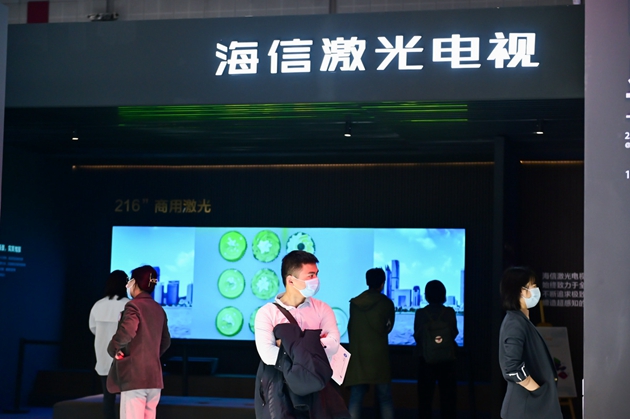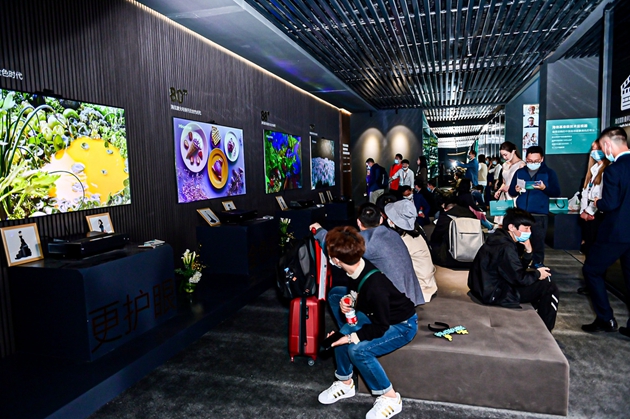China continues rapid pace on laser TV development

Hisense laser TVs attract visitors at the Shanghai Appliance & Electronics World Expo in March. [Provided to chinadaily.com.cn]
China is leading the world in the research and manufacturing of laser TV, an anticipated future trend in the TV industry according to experts and company executives.
"Over the past 20 years, the laser display has gone from a theory to a technology, and to industrial products," said Xu Zuyan, an academician from the Chinese Academy of Engineering.
The laser TV features purer colors, as the technology solves the problem of high-fidelity image reproduction, and the lasers can be precisely controlled to stay in the best visual perception area of the human eyes, Xu explained.
By the end of 2019, there were 27 companies involved in the laser display business in China, with annual revenue of 15 billion yuan ($2.3 billion), he said.
China is taking the lead in international patent applications related to laser displays, covering a wide spectrum ranging from optical components and control units to whole machine assembly.
As a domestic home appliances giant, Hisense, based in Qingdao of Shandong province, was one of the earliest players to set foot in the field of laser TV. It started research in 2007 and launched its first 100-inch laser TV in 2014, and has so far filed more than 1,400 patent applications in China and overseas, with 575 granted.
"A variety of new display technologies are emerging, including OLED, QLED and laser," said Liu Xianrong, chief executive and head scientist at Hisense's laser display division. "We believe compared with others, laser TV or laser display technology has more room for future development.
Consumers always want a bigger TV in their room, and laser projection can make a larger image more easily."
In addition, compared with the traditional liquid crystal display, the laser display technology is cost-effective when the size of the screen enlarges, leading to more reasonable prices for large TVs, Liu said.
"Besides improving color and reducing power consumption, we have also made effort to enhance product reliability and durability, and conducted comprehensive research on display quality," he said.

Hisense laser TVs attract visitors at the Shanghai Appliance & Electronics World Expo in March. [Provided to chinadaily.com.cn]
In 2019 and 2020, Hisense organized the Global Laser Display Technology and Industry Development Forum, inviting manufacturers, suppliers, retailers and consumers to promote the development of the industry.
In 2017, the sales revenue of Hisense's laser TVs was only 15 percent of all OLED TVs in China, but in 2020, that number increased to nearly 70 percent. "That means the laser TV is developing faster than the OLED TV, and the laser display technology is well recognized by the market and consumers," Liu said.
The products are also welcomed in the global market.
"We entered entertainment retailers first, as their professionalism ensured a better understanding of the laser display technology, and consumers there tended to accept laser TVs that are more expensive," said Ming Zhaoliang, vice-general manager for Hisense's international marketing. "With that customer basis, and with reduced cost, we marched on into mainstream consumer electronics channels."
Hisense laser TVs are now available at a number of renowned international home appliances retailers, such as Best Buy in the United States, Heimkinoraum in Germany, Boulanger in France and JB Hi-Fi in Australia.
According to market research company Omdia, sales of ultra-large TVs -- 80 inches or bigger -- will reach 2 million globally this year, which is expected to double by 2025. Laser displays will be a main technical route in the segment.
"Hisense has made huge breakthroughs in the high-end, ultra-large TV market, accounting for more than half of all laser TVs sold last year nationwide," said Zhang Bing, Omdia's director for consumer electronics market research. "The consumers are upgrading their consumption behavior, calling for new technical advancement from the manufacturers, which in turn will push further development of the market."









 Play
Play  Play
Play